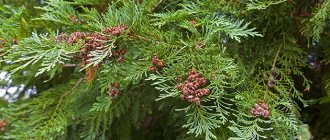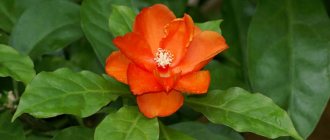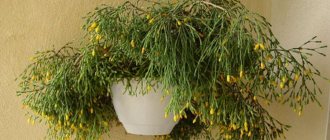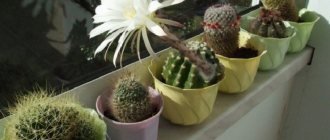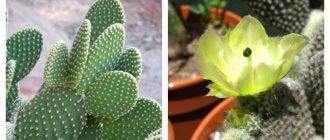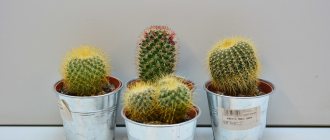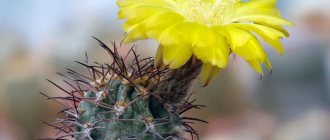The genus Lophophora , also called peyote, is of particular interest among the numerous representatives of the cactus family (Cactaceae). This genus, according to various sources, unites from 1 to 4 species of cacti. In nature, they can be found on low mountain slopes in dense bushes in Mexico, as well as the United States.
Of all the representatives of the cactus family, this plant stands out for its extremely unusual composition of juice, which contains a variety of alkaloids. Juice can have a healing and tonic effect on the human body, but only if it is used in small doses. When consumed in large quantities, the juice can cause hallucinations. In this regard, the cultivation of such a plant is prohibited in a large number of countries around the world.
This plant is divided into species most likely based on the chemical composition of its juice. For example, Lophophora procumbens produces the most pellotine, while Lophophora Williams produces the most mescaline. Externally, the species have virtually no differences. However, a large number of specialists divide this plant into species precisely according to these characteristics. But many experts note that a cactus of one species may exhibit signs of a completely different species.
The lophophora cactus has a stem in the shape of a slightly flattened ball, which reaches a diameter of 15 centimeters. This green-blue fleshy and rather smooth stem has a soft and velvety surface to the touch. You may get the impression that it consists of separate convex segments that have fused together and swollen. There can be either 5 of these segments, with the upper part of the cactus seeming to be divided into 5 equal parts (ribs), or a lot. In this case, many tubercles can be found on the stem of the plant. Among a large number of cacti, you can see specimens that look like they are bristling with pimply combs.
In the central part of each individual segment there is an areola, from which emerges many hairs, collected in a thick tuft and colored straw-colored. In an adult specimen, most of the hairs are located directly at the apex, since the growing young segmental lobes of the cactus are located there. In spring, flower buds form in such places. Flowering is observed in summer. Tubular, semi-double, multi-petaled flowers are not very large, about 2 centimeters in diameter. They can be painted in various color shades from pale red to snow-white. When the plant fades, it produces red-pink two-centimeter fruits containing small black seeds.
This type of cacti stands out among the rest for its massive turnip-shaped root, which has a large number of rather thick shoots. The diameter of this root is almost equal to the diameter of the stem itself; when measuring, by the way, all existing children are taken into account. The root is also very long, so its length is usually greater than the height of the stem.
Care
Lighting
Cereus cactus loves sunny color. It is recommended to keep it on a loggia or balcony in a south, south-east direction. Sunlight should be present in sufficient quantities at any time of the year. If in winter there is not enough light, you can use special phytolamps.
Temperature
Cereus is not picky about temperature conditions. Quite hardy and can withstand heat without any consequences. However, there are certain requirements:
- In winter, the plant requires an optimal temperature regime, as a rule, this regime is 8-10 degrees.
- In warmer seasons, it is recommended to keep the plant outdoors more. The cactus tolerates temperature conditions in the spring-summer period (15-30 degrees) favorably.
Watering
- Cereus should not be watered with hot or cold water; warm water is optimal. So, the use of soft, settled water is not recommended;
- Watering should be moderate in spring and summer;
- In autumn, watering should be gradually reduced in preparation for the winter season.
- In winter, the cactus should be watered rarely; watering should be reduced to once a month. The cactus should not be over-watered; excess moisture is detrimental to the plant. Due to waterlogging it may rot.
Humidity
This aspect of humidity is very important for cereus. It is recommended to spray the plant with clean and warm water in the warm months of the year. Spraying will help it endure hot days and accumulate the required liquid without waterlogging.
The soil
The soil should be neutral or acidic, but not alkaline. When creating soil yourself, you must include a small amount of fine brick chips and river sand. Soil with a large amount of humus is not suitable for Cereus.
Fertilizers
Feeding for cereus occurs from mid-spring to mid-summer. It is recommended to use liquid fertilizers according to the instructions. In summer, the cactus grows actively; it needs special microelements for healthy development.
Rest period
The dormant period occurs in winter. It is recommended to place the cactus in a bright and warm place. At this time, feeding is not required. And watering can be reduced to once a month (but it is better not to water at all than to water more and more often).
Transfer
The first transplant is carried out when the plant is still young. It is necessary to change the pot to a wider one, but not a deep one. Mature plants need to be replanted every two to three years. For transplantation, take a shallow pot; a layer of drainage is placed on the bottom. Drainage may consist of expanded clay or pebbles. There must be holes at the bottom of the pot that serve as drains for water.
How does prickly pear fig reproduce?
There are only two ways to propagate prickly pear, and vegetative methods are most often used.
Germination of seeds
The seed propagation method is perhaps the most labor-intensive. Before sowing, prickly pear seeds should be rubbed with sandpaper or a nail file. After this, the material is filled with water for several hours. The soil for planting should consist of perlite, universal soil and charcoal. The seeds are planted in the soil, slightly pressing into it. Plantings need to be moistened with a weak solution of manganese and covered with glass or film. Containers should be ventilated in the morning and evening
It is important that the soil is not dry or very wet
Note! Shoots may take several months to appear, you should be patient
Rooting cuttings
The vegetative method of propagating cacti is more acceptable. The cutting can be taken at any time, but it is best to plant it in spring or summer, when maximum plant development occurs. The segment is cut off and left to dry for several days. After this, the cuttings are deepened a third into a mixture of ready-made soil for cacti and sand. The planting needs to be watered, but rooting can occur in a few weeks or even months.
There is another way of rooting. The spines are removed from one side of the segment and this side is deepened into the ground. Next, you should water the soil around the cutting. Roots will form throughout its entire area. When the cactus begins to grow, you can reduce watering and let the soil dry out for several days.
Lophophora cactus
The genus Lophophora, also called peyote, is of particular interest among the numerous representatives of the cactus family (Cactaceae). This genus, according to various sources, unites from 1 to 4 species of cacti. In nature, they can be found on low mountain slopes in dense bushes in Mexico, as well as the United States.
Of all the representatives of the cactus family, this plant stands out for its extremely unusual composition of juice, which contains a variety of alkaloids. Juice can have a healing and tonic effect on the human body, but only if it is used in small doses. When consumed in large quantities, the juice can cause hallucinations. In this regard, the cultivation of such a plant is prohibited in a large number of countries around the world.
This plant is divided into species most likely based on the chemical composition of its juice. For example, Lophophora procumbens produces the most pellotine, while Lophophora Williams produces the most mescaline. Externally, the species have virtually no differences. However, a large number of specialists divide this plant into species precisely according to these characteristics. But many experts note that a cactus of one species may exhibit signs of a completely different species.
The lophophora cactus has a stem in the shape of a slightly flattened ball, which reaches a diameter of 15 centimeters. This green-blue fleshy and rather smooth stem has a soft and velvety surface to the touch. You may get the impression that it consists of separate convex segments that have fused together and swollen. There can be either 5 of these segments, with the upper part of the cactus seeming to be divided into 5 equal parts (ribs), or a lot. In this case, many tubercles can be found on the stem of the plant. Among a large number of cacti, you can see specimens that look like they are bristling with pimply combs.
In the central part of each individual segment there is an areola, from which emerges many hairs, collected in a thick tuft and colored straw-colored. In an adult specimen, most of the hairs are located directly at the apex, since the growing young segmental lobes of the cactus are located there. In spring, flower buds form in such places. Flowering is observed in summer. Tubular, semi-double, multi-petaled flowers are not very large, about 2 centimeters in diameter. They can be painted in various color shades from pale red to snow-white. When the plant fades, it produces red-pink two-centimeter fruits containing small black seeds.
This type of cacti stands out among the rest for its massive turnip-shaped root, which has a large number of rather thick shoots. The diameter of this root is almost equal to the diameter of the stem itself; when measuring, by the way, all existing children are taken into account. The root is also very long, so its length is usually greater than the height of the stem.
Possible problems in cultivation and diseases
This cacti gets sick and suffers from parasites relatively rarely. If you follow all the rules of growing and care for the plant according to the recommendations of experienced specialists, then there will be no problems.
Lophophora Williams cactus in the wild
If not cared for properly, problems can arise. For example, if overwatered, a flowering cactus is susceptible to rot.
For cactus lovers, a plant called Lophophora Williams is of particular interest. Its unusual appearance leaves no one indifferent. But in Russia, the cultivation of this cactus is prohibited, as it contains the narcotic substance mescaline alkaloid, which causes auditory and visual hallucinations.
Cultivation ban in the Russian Federation[edit]
Cultivation of Lophophora williamsii
in Russia it has been legally prohibited since 2004 - criminal liability under Art. 231 of the Criminal Code of the Russian Federation occurs when more than two copies of the plant are grown. In this case
- plants grown in temperate greenhouse or window culture are physiologically different from those grown in their homeland and are physically unable to produce significant amounts of mescaline. Lophophora is an extremely slow-growing and fastidious species; with a growth rate of 5-10 mm per year, artificial breeding for the sake of insignificant amounts of the active substance is impractical
- indoor plants often produce a large number of children from one root; the ruling does not say whether such a plant is “one” or “several”
- there is no reliable way to distinguish between the prohibited Lophophora williamsii
and the non-prohibited
Lophophora diffusa
(Croiz.) Bravo, especially in window culture (see description of the genus Lophophora) - there are different approaches to the taxonomy of cacti; The resolution names the species - Lophophora williamsii
, but does not tie it to a specific taxonomy - there is not even a link to the description of the species with all subsequent clarifications.
For example, the reference cited in the title of this article to an updated description by John Merle Coulter (JMCoult.) includes plants previously classified as a separate species, Lophophora fricii
.
Description without this reference (Lem. ex Salm-Dyck) excludes Lophophora fricii - a person who is not practically familiar with North American cacti in window and greenhouse culture may mistake for plants of the genus Lophophora
and relatively close plants of the genus
Turbinicarpus
, and some species of the South American genus
Gymnocalycium - even if a single “suspicious” plant is discovered, be it a collector’s item with a fifty-year history, it is subject to destruction, and the owner is subject to administrative punishment.
Caring for lophophorus cactus at home
This plant can be grown successfully indoors.
But in order for the cactus to grow and develop correctly, it is necessary to provide it with suitable conditions.
Illumination
Lophophora needs the brightest light, but at the same time it must certainly be diffused. The surface of the cactus should not be exposed to direct rays of the sun, as this may cause the trunk to partially change its color to reddish, and the plant itself will slow down its development and growth.
Feels great in low air humidity in a city apartment.
No additional moisturizing is required.
How to water
The watering schedule depends on the room temperature, time of year, and the condition of the substrate. In the summer, watering is started 1–2 days after the substrate in the pot has completely dried. At the end of September, the cactus stops watering completely. Watering begins again only in March. If you continue to water the lophophora during a cool winter, then rot may appear on it.
Temperature
For lophophora in summer, moderate air temperatures are best suited.
It can withstand quite high temperatures (up to 40 degrees). In winter, this plant should be moved to the coldest place, where it will not be higher than 10 degrees, but it must be taken into account that during the entire winter period it also needs good lighting.
Top dressing
Feeding is carried out only during the period of intensive growth, once every 4 weeks. To do this, use special purchased fertilizers intended for cacti.
How to replant
While the lophophora is young, it is replanted once a year in the spring. A mature plant should be subjected to this procedure only as needed and only after the root system has finished being placed in the pot.
During transplantation, you can cut the roots, but not more than ¼ of the part. After trimming, it is recommended to treat the cut areas with charcoal and dry thoroughly. Then the cactus can be transplanted into a fresh pot.
Earth mixture
Suitable soil must be loose, well-permeable to water and air, and also have neutral acidity. In order to choose a good soil mixture, it is necessary to take into account that it must contain 1 part of soil saturated with nutrients and 2 parts of various loosening additives. So, to prepare a suitable soil mixture, it is necessary to combine turf soil, brick chips and perlite, which must be taken in a ratio of 1: 1: 2.
Experienced gardeners also advise adding a small amount of bone meal to the soil.
Due to the fact that the cactus has massive roots, the pot must be suitable, or rather, the highest. Don't forget to make some nice small stones. A thin layer of fine gravel should be spread over the soil, and it should cover the root neck of the cactus.
Reproduction methods
The easiest way to grow a cactus is from seeds. They can be sown throughout the year. In this case, you will find instructions on growing seedlings on the package with seeds.
Lophophora can also be propagated by “babies”.
To do this, they are carefully separated from the mother plant in the autumn. Then the “babies” must be placed on a layer of perlite and maintained in the same way as an adult cactus in the winter (do not water). With the arrival of spring, the “babies” should form roots. Replant them in permanent pots.
Pests and diseases
This plant practically does not get sick, and harmful insects do not settle on it. Often, gardeners are worried that the lophophora seems to stop growing. But this is completely natural, because this plant is slow-growing and the growth of its stem is only 5–10 millimeters in 1 year.
Description
Lophophora Williams (Williams) has a green-blue stem, smooth fleshy, soft to the touch surface. At first glance, it seems that the plant consists of convex individual segments fused together. There can be five or more such parts. There are many tubercles visible on the stem of the plant. Among these cacti there are specimens with bristling pimply combs.
In the center of each individual segment there is an areola, from which emerges a large number of hairs, straw-colored and collected in a thick tuft. The adult specimen has the largest number of hairs located at the apex. There are young growing segmental lobes of the cactus. In spring, flower buds form in these places.
Lophophore Williams stands out for its turnip-shaped massive root, which has a large number of thick shoots. Its width is almost equal to the diameter of the stem. Unlike the above-ground part of the plant, the length of the root system is quite decent.
There are several forms of this variety: deceptive, five-ribed, multi-ribed, combed and bushy.
Lophophora williamsii - cultivation
Lophophores are a valuable and very interesting material for cactus growers, and they are an adornment to any cacti collection. Externally, these are small cacti with spherical, somewhat flattened, smooth stems about 3 cm high and about 5 cm in diameter. Their surface is covered with a velvety epidermis of dull gray or bluish-gray color. The massive root of the lophophora has a turnip-like shape. The surface also has from 6 to 10 slightly convex ribs. They are very wide, especially near the areolas, and separated from each other by thin and clear grooves. The ribs also have transverse grooves that form softly defined tubercles.
The areoles are large and white-pubescent, sparsely located on the stem, and in the upper part of the stem they contain tufts of white or gray hair. Lophophorans have practically no spines. During flowering, flowers appear on the stems, up to 2 cm in diameter, colored white, soft pink, hot pink, and yellow. They are wide open, funnel-shaped, sessile. They usually appear near the growth point. The fruits appear 9-12 months after flowering. They are oblong, about 1 cm long, pale pink in color. Each fruit contains several seeds.
Mature plants that have a turnip-shaped large root should be kept in deep pots that cover the height of the root system. As a substrate, mixtures are used containing up to 60% sandy-clayey soil mixed with equal parts of expanded clay and gravel chips, with the addition of up to 20% leaf soil, and the remaining 20% - any fillers.
In general, if you follow a few mandatory rules, caring for these cacti is not difficult. In the summer months, lophophores are placed in a sunny place, and they try to keep the substrate moist. To avoid stalling of the pubescence of the areolas, it is better not to spray. As the weather gets colder and in autumn, watering is gradually reduced. to prepare the plants for a completely dry winter. which is carried out at a temperature of 6-10 oC.
With the arrival of spring, even stems that have shriveled during winter gain turgor as the temperature and humidity of the environment increase, and their tops turn green, but early watering should not provoke the plant to awaken. During this period, lophophores need to be shaded from direct sunlight for the first time to avoid burns. Watering can be resumed only after the plants have begun to grow. Lophophora are propagated mainly by crops. At the same time, freshly harvested seeds germinate amicably and develop relatively quickly. And with proper maintenance, lophophores reach the flowering state 3-4 years after sowing, and sometimes even earlier.
To save rotten specimens or for commercial purposes to force out seedlings, vaccinations are used. Such grafted specimens often “baby” abundantly, which opens up prospects for vegetative propagation of this plant. Lophophora shoots, cut at the root, take root quite easily after drying. Rooting shoots in the fall also gives good results. To do this, they are placed on a layer of perlite and kept in wintering conditions until spring. By spring, the cuttings, as a rule, form powerful waiting roots, after which the plants are ready to be placed on the ground. If you cut off the main stem at the root collar, the remaining intact root system often forms one or several stem shoots at the cut site.
How Williams' lophophore reproduces
The plant is mainly propagated using seeds; propagation by lateral shoots is also used.
Opuntia cactus: examples of plant care and propagation
In place of faded flowers, pink-red berries of identical size are formed, each containing an average of 5 to 10 black seeds, which can be sown all year round.
When buying seeds, special instructions may be attached to them; in other cases, they are soaked for a couple of hours in distilled water, dried with a paper napkin and evenly distributed over a moistened substrate consisting of a portion of vermiculite, two parts of leaf humus and one part of charcoal at a distance of at least 15 mm from the border containers.
Germination will take from 3 to 7 days, and the necessary conditions include:
- good diffused lighting;
- cover with a plastic bag.
- temperature from 23 to 25 °C;
- ventilation every day;
- one hundred percent humidity.
Note! The soil mixture for seedlings must be sterilized before the 2nd picking.
Within 2-3 weeks after the sprouts appear, picking is carried out at intervals of 2-3 mm, pulling the bag over the container overnight and watering sufficiently so that the soil does not dry out.
The second picking is carried out in the soil for adult cacti by closing the seedlings. Watering is reduced until the soil dries out. When the plants reach 1.5-2 cm in diameter, they are planted separately.
During vegetative propagation in the fall, the grown cuttings are carefully cut from the main stem, and the cut of the trunk should be air-dried for a day. Young shoots are placed on perlite without watering and kept in conditions identical to adult lophophores during the dormant period. By spring, they produce roots, after which they are planted in pots.
Reproduction
There are two ways to propagate Gymnocalycium: by seeds and by lateral layering.
The first method makes it possible to obtain higher quality and healthier offspring. The seeds are planted in a small pot with a moistened mixture. Before planting, the soil must be calcined in the oven for disinfection. At first, it is better to cover the seeds with a film or a lid so that the soil is constantly moist. At the same time, do not forget to spray or water through the pan. A temperature of 18-20 degrees is suitable for seed germination. Within a year, the seedlings can be planted in separate pots. You can plant seeds at any time of the year. The main thing is to comply with all conditions.
The second method is simpler. It is necessary to separate the side cuttings from the main stem and dry the cut area for several days. To do this, place the shoot on the newspaper. Let it sit for a few days. Then we plant it in moist soil. It will take root very quickly, and you need to care for it like an adult cactus. If the children have roots, then you need to carefully dig it out and transplant it into a separate pot.
Features of the plant
You may be interested in: A greenhouse is... Concept, types, purpose and photo
Of all the representatives of this family, lophophora stands out for its rather unusual and unique composition of juice, containing a variety of alkaloids. Thanks to this, it can have a tonic and healing effect on the human body, but only when used in small doses. Drinking the juice in large quantities can cause hallucinations, so the cultivation of this plant is banned in many countries around the world, including Russia.
This cactus is divided into several types, including according to the chemical composition of the medicinal liquid. For example, the spreading lophophora has an increased level of pellotin, while the Williams lophophora produces mescaline to a greater extent, although they are practically no different in external signs.
You may be interested in: How to grow hosta from seeds: planting and care features. Host varieties
It should also be noted that many experts have noticed: cacti of one variety may have characteristics of a completely different species.
Conditions for growing indoors
Growing Gymnocalycium mihanovichii is not difficult if you follow the general recommendations for keeping cacti.
Placement and lighting
Gymnocalycium prefers bright, intense, but diffused light and does not tolerate direct sunlight. The scorching sun can cause burn spots to appear on the surface of the stem.
The optimal place to place a flower pot is the eastern or western windows of the apartment; additional shading may be required on the south side, and an artificial light source on the north side.
Temperature
Gymnocalycium is unpretentious to temperature; it feels equally good in the range of +15...+30°C, provided that this temperature is constant. Sudden changes and drafts can be detrimental to a flower.
Air humidity
This variety, like other types of cactus, tolerates low humidity well and does not require additional moisture measures. On the contrary, spraying the stem can cause the flower to rot.
Similar flowers
- Lophophore diffuse - has a spherical flattened shape, approximately 15 cm in diameter, matte surface, yellowish-white flowers up to 2 cm in diameter.
- Lophophora lutea - has a stem of a yellowish-green, brown or gray hue, with a diameter of no more than 10 cm. The flowers are yellowish-white or light yellow, with a diameter of no more than 3 cm.
- Greening lophophora - has a dark green spherical stem, no more than 20 cm in diameter, with numerous ribs along its entire length. The flowers are white, diameter no more than 2 cm.
- Lophophora hedgehog - has a bluish-green stem, no more than 13 cm in diameter, with ribs and tubercles. There are tufts of wool on the surface. The flowers are white, diameter no more than 2 cm.
- Lophofra mescaline is a small cactus, no more than 8 cm in diameter, gray-green in color (learn about small cacti in this material). The apex is rounded, and there are tufts with white hairs on the surface.
We have collected everything you need to know to successfully grow Lophophora in this article.
Thus, Lophophora Williams is one of the most unpretentious cacti, and at the same time it has an unusual appearance and blooms, subject to simple care rules, all summer, delighting its owner with beautiful flowers.
Home care
Temperature and light. Despite the fact that a temperature of +40 degrees Celsius will not harm the plant, it is still necessary to ensure optimal temperature conditions. With the onset of winter, ensure coolness - no higher than +10 degrees. The plant needs bright light, but if you overdo it and allow direct sunlight, the stem will change its color to red, and the plant will grow and develop even more slowly. Therefore, it is necessary to provide diffused light. Watering. The intensity of watering depends on factors such as time of year, soil condition
In summer, you need to water as soon as the soil dries completely. Important! From September to March it is recommended to stop watering, otherwise the plant will freeze and die!
The soil. The main criteria for soil preparation are its looseness and good water permeability.
Suitable acidity pH 6-6.5. It must be taken into account that good soil should consist of 1/3 organic matter, and 2/3 drainage. To fill with organic matter, you can use the following: chernozem, leaf humus. For drainage filler: coarse sand, marble or brick chips, perlite. Experienced gardeners recommend adding a little bone meal to the soil.
Pot. When the cactus is still young, the pot is changed every year in the spring, and then as needed. When choosing a pot, it is worth considering that the plant has powerful roots, so you need to pay attention to its height. Transplantation. Before replanting, you should not water the plant for seven days, and you should also keep it away from direct sunlight. During transplantation, you need to cut off 1/4 of the plant's root system. To prevent rotting, sprinkle the cut area with crushed activated charcoal or charcoal and dry it. A drainage layer is placed at the bottom of the new pot, followed by an organic mixture. After transplantation, you must follow step 1.
Feeding. The cactus should be fed only during the period of active growth, once a month. Use special fertilizers for cacti.
Wintering. For the winter, Lofofora needs to ensure a temperature regime of no higher than 10 degrees Celsius and stop watering. Transplantation is prohibited during this period.
Difficulties in growing
Despite the unpretentious nature of Gymnocalycium, gardeners often encounter problems when growing it. They are usually caused by violation of flower maintenance rules or disease.
Diseases
Gymnocalycium is highly resistant to disease, but it can develop root rot, which can lead to the death of the plant. This is usually caused by overwatering or planting in an overly fertile substrate.
You can cope with the disease by removing the affected shoots of the root system, after which the remaining roots are washed with water and treated with a fungicidal agent (for example, “Praktik”).
Pests
This variety of cactus is characterized by infection with some specific pests:
- Red flat mite is a nasty pest that only attacks young plants. Its presence appears in the form of brown spots on the stem of the flower. In the early stages, when there are few spots, it is enough to wash the stem with a warm soapy solution. In more advanced cases, they resort to the use of industrially produced acaricidal agents (for example, Akarin) according to the instructions;
- Mealyworm affects plants of any age, most often causing damage to the root system and the base of the stem. To destroy it, the plant is thoroughly washed with hot water, and then watered with water with the addition of an insecticide (for example, “Thunder”) in accordance with the manufacturer’s recommendations.
Prevention will help you avoid troubles when growing Gymnocalycium:
using special soil for cacti; proper organization of irrigation (it is important to prevent water stagnation and waterlogging of the soil); use of drainage; watering the flower only with soft, settled water to prevent alkalization of the soil.
So, having examined the characteristics and features of Gymnocalycium Mihanovich, we can conclude that this plant is ideal for home cultivation due to its unpretentiousness. The cactus not only takes root well and reproduces quickly, but also regularly delights with long-term flowering if you follow the rules of caring for it.
Pests and diseases
The lophophora cactus is little susceptible to parasites and infections. Problems arise mainly when content rules are violated. The cactus grows slowly, the increase per year is no more than 1 cm. Therefore, a slow growth rate is the norm, and not a manifestation of disease or a sign of parasite damage.
Diseases can be caused by bacteria, viruses, fungi. Most often, the pathogens are the so-called plant owners. Microorganisms live in the soil and on the stem of the cactus without showing pathological properties until the environment serves as a trigger. For example, excessive watering can cause the aggressive properties of bacteria to manifest and lead to various rots.
Caring for astrophytum at home
Illumination
It loves bright light and the cactus needs good lighting all year round. Can be placed on southern windowsills. At the beginning of the summer, shading from direct sunlight is required.
Temperature
They love warmth. In summer, a temperature of 20–25 degrees is needed. A temperature difference between night and day is needed, so it is better to place the plant outside in the warm season, but be sure to protect it from precipitation. In winter, place in a cool room (10 degrees) and systematically ventilate it.
How to water
In summer, watering is done after the earthen ball has completely dried, and in winter - when the cactus begins to dry out. Even a few extra drops can harm the plant. It is recommended to water from a tray to prevent moisture from entering the lower part of the stem, which is very sensitive. With the onset of autumn, the astrophytum is watered less and less each time, and in the winter months the ground should be dry. For irrigation, you can use limestone hard water.
Fertilizer
When the period of active growth begins, the plant needs feeding. To do this, use complex mineral fertilizers for cacti (1/2 of the recommended dose). Fertilize the soil once every 4 weeks. In winter, the cactus is not fertilized.
Features of transplantation
Transplantation is carried out extremely rarely, only when the roots no longer fit in the pot. During transplantation, make sure that the root collar is not buried, otherwise it may rot. The flower pot should not be much larger than the previous one.
For the drainage layer, you need to use expanded clay or broken brick. It is recommended to make the top layer of decorative, small stones of different colors. This way you can avoid the plant coming into contact with water.
Earth mixture
You can make the soil mixture yourself by mixing leaf, turf and peat soil, as well as sand in equal proportions. You also need to add brick chips, and it is also recommended to add crushed egg shells. The earth should be slightly acidic, or preferably neutral.
How to propagate
Propagated by seeds. Sowing is done in the spring. The temperature should be between 20–22 degrees. Sprouts will appear very soon.
Main types
There is a classification dividing this plant into several types:
Lophophora Williamsii
The stem reaches a height of 7 cm and a diameter of 12 cm. Pinkish-white flowers. There are several forms, namely: five-rib, deceptive, multi-rib, bush and comb.
Lophophora Fritsch (Lophophora Fricii)
The trunk reaches 8 cm in height and 12 cm in diameter.
Carmine red flowers. There are 14 spiral ribs.
Lophophora Jourdaniana
The stem reaches a height of 6 cm and a diameter of 7 cm. Purple-red flowers. There are 14 spiral ribs.
Lophophora is one of the unique representatives of the cactus genus.
The second name that is mentioned in some scientific literature is peyote. There are from 1 to 4 species of cacti in the genus. In nature, they are found on mountain slopes close to dense bushes that inhabit Mexico and the USA.
In addition to its unusual appearance, scientists have found a rare composition of cell sap, which contains unique sets of alkaloids. The juice of the plant has medicinal and tonic qualities, but is allowed for consumption only in limited quantities.
Exceeding the dose can provoke impaired consciousness and mental differences. Therefore, the breeding of lophophora is prohibited in a number of countries around the world.
When grouping the plant into individual species, botanists were guided by differences in the chemical composition of cactus juice. Lophophora procumbens produces a substance called pellotine. The presence of mescaline in the tissues is typical for Williams' lophophore. The difference in coloring or structure is virtually invisible. Although experienced specialists mention one fascinating fact: a certain species can show signs of a completely different cactus form.
Varieties of peyote cactus
Lophophora Williamsii has a stem about 7 cm high and 8 to 12 cm in diameter. The flowers are pink and white. The plant has a multi-ribed, flattened, spherical shape without spines. The areoles are bare or covered with a dense carpet of hairs, which is why the entire surface of the cactus appears fluffy. It blooms several times during the period corresponding to the wet season in the native territories of the plant. The flowers are small, no more than 2–3 cm in diameter, located at the top of the stem. The oval-shaped fruits are reddish in color; inside the fruits there are black seeds. The root system is turnip-shaped. During the dry season, the plant's protective ability appears in the wild. The root contracts and draws almost the entire above-ground part of the cactus into the soil. Lophophora Williams is found most often in the northern regions of Mexico.
Lophophora Williamsii Peyote. Peyote lophophora is a small, squat plant with a matte brown stem. The stem height is 10 cm, diameter is 7 cm. The outline of the lophophore resembles a mushroom. The cactus at the top has several areoles without needles. Typically the plant is divided by grooves into eight ribs. The flowers are pale pink, 1.5 cm in diameter, decorating the upper part of the stem. The fruits are light pink with black seeds inside.
Fritsch's lophophora. The diameter of the spherical stem is 12 cm, height 8 cm, 12 spiral ribs. The flowers are deep red.
Lophophora spreading. The stem is green-yellow. Flowers up to 2 cm in size with yellow-white or white elongated petals. The cactus prefers the shade of bushes. Grows in Texas.
Lophophora of Jourdan. Stem diameter 7 cm, height 6 cm, 14 ribs in a spiral shape. The flowers are violet-red.
Lophophora yellow. Diameter 10 cm. The color of the stem is green-yellow with a brown-gray tint. The ribs are slightly marked and practically absent. Diamond-shaped tubercles are clearly visible, arranged in a spiral pattern along the surface of the stem. The areoles are covered with a fringe of hairs. The flowers are light yellow, up to 3 cm in size.
Lophophora hedgehog. Diameter 12 cm, 10 ribs. The stem is dark green with a bluish tint. The areolas are covered with a dense carpet of hairs. The flowers are white, 2 cm in size. The fruits are pale pink.
Lophophora green. The largest variety of lophophora. Diameter 20 cm, numerous ribs. The stem color is dark green. The flowers are bright white, up to 2 cm in size. In the wild, it prefers the rocky deserts of Mexico.
Lophophora mescaline. Height 10 cm, diameter 10 cm. The color of the stem is grayish-green. It is distinguished by a rounded tip and a large number of areoles with whitish hairs. The root is shaped like a carrot.
Transfer
Until the age of three, young cacti are replanted every year, adult plants - once every three years or more often (if there are signs of insufficient growth and vegetation).
Reference! A pot or flowerpot is selected 3-4 cm larger in volume than the previous container.
Subtleties of transplantation:
- The pot is filled with soil mixture for desert cacti. Expanded clay and gravel are poured onto the base for drainage purposes. The next layer is 2-3 cm sand;
- Examine the roots of the cactus. Damaged, diseased areas are trimmed. The rhizome can be shortened by a quarter of its length;
- The cactus is evenly immersed in the substrate, the roots are straightened. Easy to compact;
- First sand is poured around the neck, then a layer of gravel. The filling level is 1.5 cm. This measure is necessary for the outflow of excess moisture.
The transplanted Lophophora is kept for 5-7 days in a shaded place, without watering, to dry the soil (the wounds heal and heal). Over the course of 10 days, the plant is gradually accustomed to light and full illumination.
Root pruning
If, during replanting, they discover that the root system is overgrown, careful pruning is carried out. For trimming:
- The cactus is removed from the container, the remaining soil is cleaned off;
- Disinfect the blade of a knife or scissors with potassium permanganate;
- Cut off one fourth or one third of the roots;
- The cut areas are dusted with coal powder and dried;
- Transplanted into a new pot.
